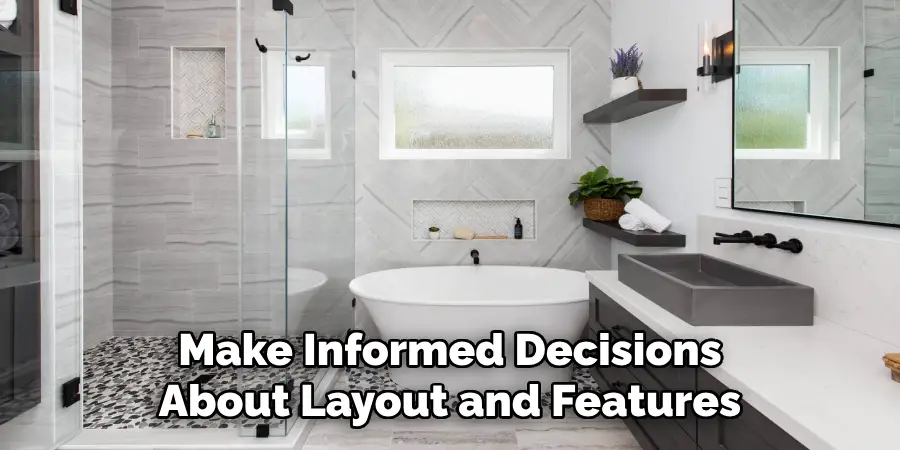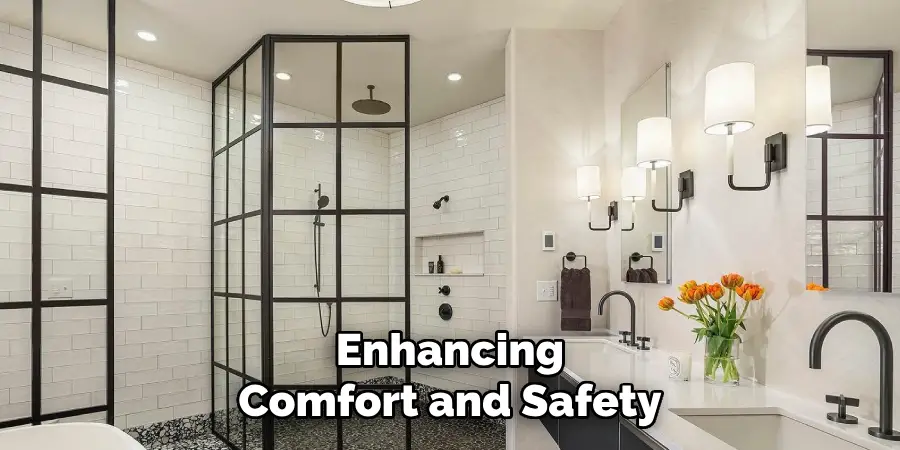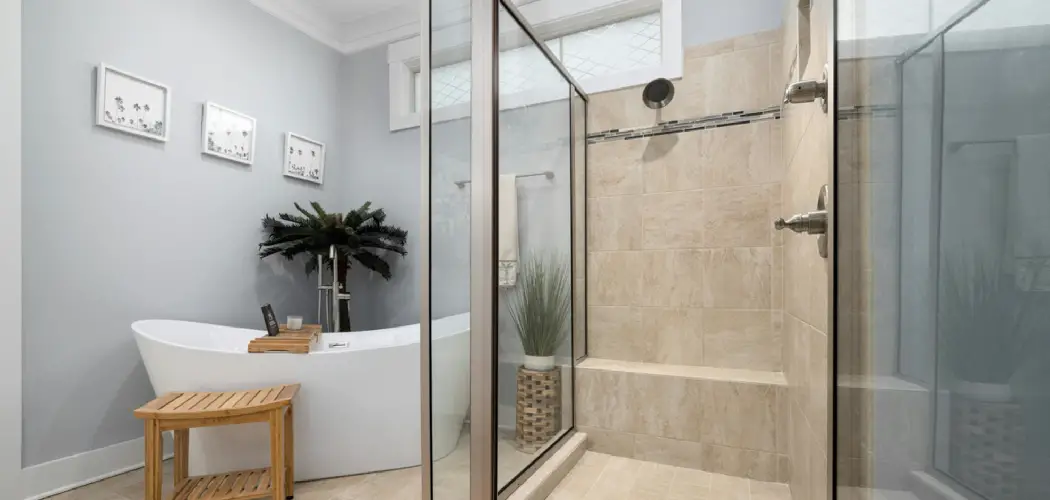A well-designed shower is essential for enhancing a bathroom’s functionality and aesthetics, transforming it into a personal sanctuary that caters to your lifestyle needs. Understanding how to design a shower involves considering multiple factors, including space, style, and functionality, to ensure a harmonious blend of practical use and visual appeal.

The size and layout of the bathroom, personal preferences in terms of style, and necessary features all play a role in the design process. From planning the layout, selecting stylish yet durable materials, choosing appropriate fixtures, and considering plumbing needs to the final installation, each step must be approached carefully. By meticulously planning every detail, you can create a shower space that meets your requirements and enhances your home’s overall ambiance.
Assessing Space and Layout
When designing a shower, the first step is to accurately measure the available space. A precise understanding of your shower area will enable you to make informed decisions about layout and features. Begin by measuring the height from floor to ceiling to ensure ample room for showerheads and fixtures. Next, determine the width and depth of the area, keeping in mind existing bathroom features such as walls, doors, and obstructions. Make sure to account for existing plumbing and drainage systems, as these elements often dictate where certain fixtures can be installed and may require professional modification if relocation is needed.
Once you clearly understand your space, consider the type of shower that best suits your needs. Walk-in showers offer an open feel and can be customized to fit various spaces, making them ideal for both small and large bathrooms. Alcove showers are enclosed on three sides, making them a practical choice for tight spaces and ensuring minimal water dispersion. Corner showers save valuable floor space by fitting snugly into unused bathroom corners, while freestanding showers provide a luxurious statement piece, although they require substantial floor area. Each type has its pros and cons based on space, budget, and personal preference.
Accessibility is another crucial aspect to consider. Designing a shower space that addresses the needs of all users, including those with mobility challenges, ensures safety and convenience. Important considerations include optimizing space to allow for movement, incorporating slip-resistant floors, and positioning controls within easy reach. A curbless shower entry is a smart choice for wheelchair access, while grab bars add security for elderly individuals. Thoughtful design can significantly enhance the functionality of a shower, providing a safe and comfortable environment for everyone.

How to Design a Shower: Selecting Shower Features
When designing a shower, selecting the right features is crucial to creating a comfortable and functional space.
Showerheads and Controls
Choosing the perfect showerhead can greatly enhance your shower experience. There are several styles to consider, each offering unique benefits:
- Rainfall Showerheads: Provide a gentle, soothing flow of water akin to standing in a natural rain shower. These showerheads are often mounted overhead for a luxurious, spa-like experience.
- Handheld Showerheads: Offer versatility and convenience, allowing users to direct water flow where it’s needed. They’re excellent for rinsing off and are useful for various tasks like cleaning the shower or washing pets.
- Multi-function Showerheads: Combine features, offering various spray patterns such as massage, mist, or targeted streams, giving users the ability to customize their shower experience.
It is equally important to select user-friendly controls for temperature and water flow. Look for controls that are easy to reach and adjust, with clear temperature markers and ergonomic designs. Thermostatic valves can be an excellent investment, maintaining water temperature even if someone flushes a toilet elsewhere in the house, thus enhancing comfort and safety.

Wall and Floor Options
The materials chosen for shower walls and floors not only affect the design aesthetic but also influence maintenance and longevity:
- Shower Wall Materials: Options include tiles, acrylic, or glass panels. Tiles offer endless design possibilities with various colors and patterns, while acrylic and glass provide sleek, modern finishes that are easy to clean.
- Flooring Options: Choose slip-resistant tiles or stone for flooring to ensure safety. Textured tiles or natural stone add visual interest while providing the necessary grip to prevent slipping.
When selecting materials, consider waterproofing and maintenance. Ensure all materials are sealed properly to prevent water damage and mold growth. Efficient waterproofing extends the lifespan of your shower and reduces long-term maintenance costs.
Storage Solutions
Efficient storage is key to maintaining an organized shower space. Here are some practical solutions:
- Built-in Shelves: Create recessed shelves within the shower walls to store shampoo, soap, and other essentials. These shelves keep items within easy reach while maintaining a streamlined look.
- Corner Caddies: Utilize corner space with caddies to store toiletries, taking advantage of areas often overlooked.
- Shower Benches: Provide a convenient seating option in larger showers and can double as storage space for bath products.
Keeping items organized and easily accessible not only improves functionality but also contributes to a clutter-free environment, enhancing the overall aesthetic and usability of the shower.
How to Design a Shower: Designing for Aesthetics
Creating a visually appealing shower enhances the overall ambiance of your bathroom and contributes to a relaxing and enjoyable experience.
Choosing a Color Palette
The right color palette can transform the shower area, making it feel cohesive and serene. Light colors, such as soft blues, gentle greens, and muted grays, create an airy, open atmosphere for smaller spaces. These shades reflect light, expanding the visual perception of the area and adding a sense of calm. For larger spaces, deeper hues like navy or charcoal can add sophistication, providing a bold backdrop and enhancing other design elements.
When selecting your palette, consider complementary colors that harmonize with the rest of your bathroom’s design. Use accent colors sparingly to add interest and depth, such as through towels, fixtures, or plant life, keeping the overall atmosphere balanced and cohesive.

Incorporating Lighting
Lighting plays a pivotal role in your shower space’s functionality and ambiance. Emphasize natural light whenever possible, as it makes the shower area feel welcoming and invigorating. Recessed lights are a practical choice for artificial lighting, providing ample illumination without taking up valuable space. These can be strategically placed to highlight specific areas within the shower.
Wall sconces can add a touch of elegance, softening the harshness of overhead lights and casting a warm, spa-like glow. A blend of functional lighting for tasks like shaving or applying skincare, with mood lighting for relaxation, ensures a well-rounded atmosphere that caters to all needs.
Adding Decorative Elements
Decorative elements elevate the aesthetic appeal of your shower. Consider incorporating decorative tiles or creating an accent wall as focal points. Intricate patterns or mosaic designs can draw the eye and convey personal style. Be sure to choose materials known for their durability and water resistance to withstand the humid shower environment.
Artwork or plant life can also be thoughtfully integrated into the shower area. Select pieces that resist moisture damage and complement the color scheme for added vibrancy and warmth. These elements contribute to a visually enriched space, making your shower area a personalized retreat within your home.
Planning for Plumbing and Drainage
When designing a shower, it’s essential to address plumbing and drainage requirements to ensure a functional and efficient space. Understanding the underlying plumbing needs involves considering pipe sizes, water pressure requirements, and overall system compatibility. Typically, the shower’s water supply lines should be at least 1/2 inch in diameter to maintain adequate pressure and flow rates. However, larger pipes may be necessary for systems with multiple showerheads or for homes with lower water pressure. Consulting with a licensed plumber is vital, as they can assess the current infrastructure and suggest improvements or modifications that align with your design aspirations.
The right drainage system is equally crucial in shower design, as it helps prevent water pooling and potential leaks, which can lead to costly water damage over time. There are several types of drainage systems to consider, each with its own advantages and drawbacks. Linear drains, for example, are placed along the edge of the shower, allowing for a sleek, modern look and efficient water removal. They’re ideal for minimalist designs, as they blend seamlessly with the shower floor. However, they require precise installation to ensure proper slope and are often more expensive than traditional options.

Traditional round drains, on the other hand, are typically located at the center of the shower floor. They are generally more cost-effective and are familiar to most plumbers, ensuring straightforward installation. Though they might not offer the same aesthetic appeal as linear drains, they’re a reliable choice for effective drainage.
Proper drainage planning is integral to shower design, as it ensures functionality and safeguards against long-term maintenance issues. Decisions made at this stage will have lasting effects on the shower’s performance and longevity, so engaging with professional plumbers and considering all options helps create a shower that meets both practical and aesthetic goals.
Budgeting for Your Shower Design
Estimating Costs
When planning a shower design, estimating costs is a crucial step in ensuring a successful project. Break down potential expenses into key categories: materials, fixtures, and labor. Materials include tiles, waterproofing elements, and any structural adjustments required, which can range from budget-friendly to high-end selections. Fixtures encompass showerheads, taps, and features like glass doors, with pricing greatly influenced by brand and style.
Labor costs also vary widely depending on the project’s complexity and location. To set a realistic budget, research average costs within these categories and be mindful of any specific needs that may drive up expenses, like luxury fittings or custom installations. Additionally, it’s vital to allow for unexpected expenses by setting aside a contingency fund—typically around 10-15% of the total budget—to cover any unforeseen issues or adjustments.
Saving Strategies
There are several strategies to help save on costs without compromising on the quality or aesthetics of your new shower design. Consider undertaking small DIY projects, like tiling or painting, especially if you have experience or are willing to learn. This can significantly reduce labor expenses. Sourcing materials from discount suppliers or during sales events is another effective way to cut costs.
However, be cautious to ensure that any discounted materials meet all necessary quality and safety standards. While it’s important to budget wisely, investing in quality fixtures and materials is key for long-term durability and maintaining the value of your investment. Quality products may have a higher upfront cost, but they often save money in the long run by reducing the need for replacements and repairs. Making informed purchasing decisions ensures your shower looks beautiful and stands the test of time.
Hiring Professionals vs. DIY
When to Hire Professionals
Hiring professionals can be a valuable investment for your shower design project, particularly when navigating complex plumbing issues or executing custom designs. A qualified contractor or plumber can manage intricate installations, ensuring compliance with local building codes and regulations, which helps mitigate risks of future problems such as leaks or inadequate water pressure. For custom shower designs, consulting with a professional designer can bring your vision to life with personalized solutions tailored to your needs and preferences.
They offer expertise in balancing aesthetics and functionality, crafting a space that is both visually appealing and practical. Professional input is especially beneficial when dealing with structural changes or implementing high-end finishes, where precision and experience significantly impact the quality of the outcome.
DIY Shower Design and Installation
For homeowners considering a DIY approach, successful execution starts with rigorous research and thorough planning. Begin by assessing your skill level and identifying which parts of the project you can comfortably undertake. Resources such as online tutorials, home improvement courses, and DIY guides can provide valuable insights and self-help techniques.
Prioritize safety by using appropriate tools and observing standard safety practices, including turning off water supplies where necessary. Develop a realistic plan, including timelines and budget constraints, and ensure you have the necessary permits if required by local ordinances. While executing a DIY project, knowing your limits and recognizing when professional help is needed is crucial. This discernment prevents costly mistakes and ensures a high-quality finish, ultimately resulting in a gratifying and rewarding renovation journey.
Conclusion
Designing a shower involves several essential steps that ensure both functionality and aesthetic appeal. Initially, assessing the available space and determining the layout sets a solid foundation for the project. From there, selecting appropriate drainage options, materials, and fixtures becomes critical to both function and style.
Crafting a detailed budget, considering professional versus DIY approaches, and understanding the intricacies of installation are also significant steps in the process. Throughout this journey, take the time to meticulously plan “how to design a shower” that meets your needs and preferences. A thoughtful approach pays off, transforming an everyday feature into a personal oasis. The rewards of such a project are not just in a beautiful space but also in the daily joy and relaxation it brings, turning each shower into a moment of retreat and comfort.
About
Angela is the chief editor of Indoorense. She began her career as an interior designer before applying her strategic and creative passion to lifestyle and home.
She has close to 15 years of experience in creative writing and online content strategy for housekeeping and cleaning,home decorations as well as other efforts.
She loves her job and has the privilege of working with an extraordinary team. She lives with her husband, two sons, and daughter in Petersburg. When she’s not busy working she spent time with her family.

